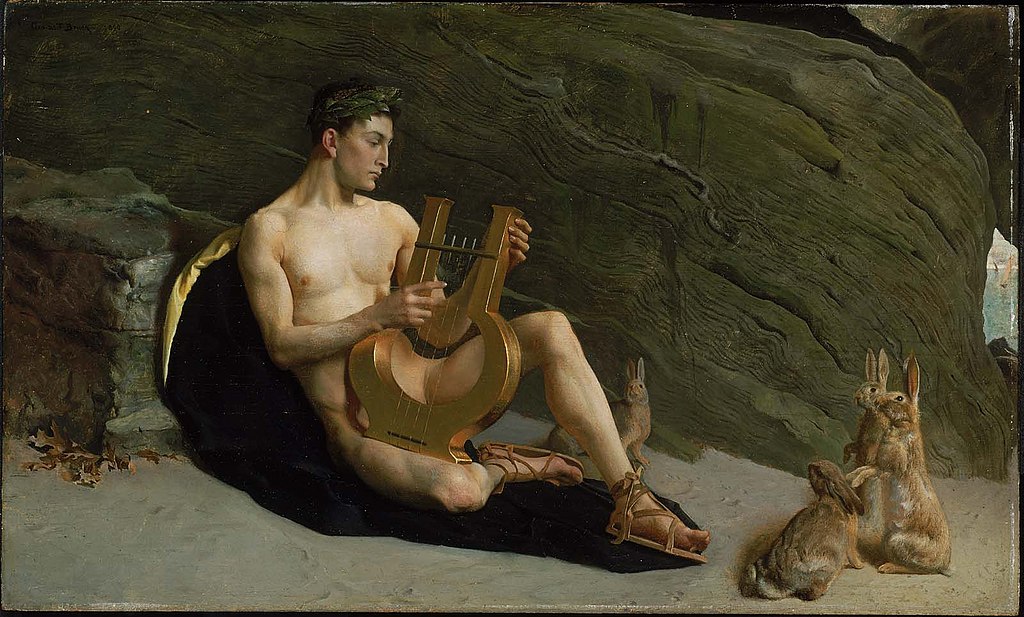Key Question: How does music shape one’s moral character and perception of society?
Key Ideas
– Kalokagathia: The unity of the beautiful and the virtuous.
– Nomos: The correct musical harmony or the “correct” social and moral values
– The Doctrine of Ethos: The belief that music has a profound impact on one’s emotions and character, affecting one’s will.
The Apollonian & Dionysian
A primal cultural tension in Ancient Greek myths and culture, Paul Henry Lang further builds on to this dichotomy (formalized in Nietzsche’s The Birth of Tragedy out of the Spirit of Music) by contrasting the following:
| Apollonian | Dionysian |
| The Lyre/Cithara (Plucking instrument) Incantation + chanting of spells that evolved to become songs Western Greece Epic and lyric poetry Nome/paean | The Aulos (Woodwind pipe with a sharp and distinct tone) Demon enchantment & witchcraft – dancing, mainly manifest in drama Asia Minor Elegy and dramatic chorus Dithyramb |
This dichotomy comes from a myth about Marsyas, a satyr playing the aulos, who challenged Apollo, playing the lyre, to a music contest and ultimately fails because of his hubris. The story of the founding of the Aulos is pretty much well-described in the wikipedia article of Marsyas, so I will not reiterate it here.
The second reason why these two particular gods stood out is because of how they eventually became the ones used by the Romans for their own political narratives.

This is a depiction of Augustus, the first Roman emperor.

Figure above is Apollo Citharoedus, meaning “the one with the Cithara”

*Off topic Rome rant (but could potentially aid your understanding of this idea I’m trying to convey):
Mark Antony, Augustus’ polical rival who has aligned himself with Cleopatra, is seen with the ivy wreath symbolizing Dionysus, and serpents, a beast often attributed to Egyptians (Lucan’s De Bellum Civile). While the Egyptians may see him as the new wine god who brings joy and revelry, the Romans, who had endured the toils of civil war for long enough, frown at the careless libertine who seems hesitant to endure the silence of peace. Antony also impairs his reputation by being with a “foreign lover”, making the people question his pietas, or civic loyalty.
On the other hand, Augustus aligns himself with Apollo, conveniently amplified by the metaphor of Caesar Jupiter that has been floating around (though Caesar became a god of his own). A god of the city, his propaganda involves an embodiment of the old Roman virtues, as contrary to Antony. It is this idea of showing the idealistic side of what made the Romans Roman (even though their corruption shapes the Roman identity just as much as their civic virtues) which made Augustus successful.
Tying this back to Apollo, he is not only the god of the sun, but also a Greek god. Dionysus is, on the other hand, often described to be an Asiatic cult. This hint of Orientalism will continue to be discussed in the next section.
Understanding the “spirit” of these two gods with its complexity/nuances has the potential to lend a comprehensive perspective into the mentality of the Hellenistic influence.
Tribal Temperaments
The Greeks base their music on seven modes, kind of like the majors and minors we speak about today.
- Ionian
- Dorian
- Phrygian
- Lydian
- Mixolydian
- Aeolian
- Locrian

They are a part of the Aristoxenian tradition, named after Aristoxenus. His book Elementia harmonica provides a systematic way for us to understand Ancient Greek music. Instead of being merely patterns of certain arbitrary intervals between notes, they mean more to the Greeks, including Plato:
As we banished strains of lamentation, so we may now banish the mixed Lydian harmonies, which are the harmonies of lamentation; and as our citizens are to be temperate, we may also banish convivial harmonies, such as the Ionian and pure Lydian. Two remain—the Dorian and Phrygian, the first for war, the second for peace; the one expressive of courage, the other of obedience or instruction or religious feeling.
Plato, The Republic Book III
- Ionian, Lydian: “convivial”
- Dorian: war, courage
- Phrygian: peace, obedience, religious feeling
- Mixolydian: lamentation
Notice here how Plato assigns characters to each mode. In modern day we may also say something along the lines of major = joyful and majestic, while minor = elegant and melancholic. However, at the time, because of the idea of the Doctrine of Ethos, the modes are seen beyond their individual palettes of emotion but instead as active parts of the citizen’s morality.
Among all of those modes, Lang emphasizes that the Dorian is favored by the Greeks because it evokes “manly poise, temperance, and simplicity”. In some ways I feel like this coincides partly with Winckelmann’s idea of “noble simplicity and quiet grandeur”.
Plato’s ethic view of music is elaborated further by:
And as we reject varieties of harmony, we shall also reject the many-stringed, variously-shaped instruments which give utterance to them, and in particular the flute, which is more complex than any of them. The lyre and the harp may be permitted in the town, and the Pan’s-pipe in the fields.
Plato, The Republic Book III
Here we see how the flute is rejected by Plato in an ideal society because of how it “give[s] utterance” to “intemperate” melodies that may affect one’s mind. This is also part of the reason why the lyre is more well-known than the Aulos; the Greeks like to use it too as a part of their self image. The Aulos is often seen as associated with their Asiatic enemies, Thus not only is it rejected by the Greeks, but also by later cultures who see themselves as the descendants of Hellenism.
Solon, one of the “seven sages of Greece”, pushes this further; he seeks to promote morality and responsible citizenship with music. He also prohibited slaves to study music so that it becomes exclusive education for the Athenian citizens, specifically the nobility. You see- everything has the potential to rise, to become a City Wall.
The Nome (νομος)
The lyre is the preferred instrument when it comes to accompanying the rhapsodes (performers who orally recite epic poetry) as they are reciting epic poetry. Music starts in and continues to be closely intertwined with literature. The lyre is often used explicitly as a literary image in Epic poems, which is why we associate it with Hellenistic culture.
The rhythm of the Nome, like many forms of music at the time, is catered to the poetic meter of the lyrics. One of the earliest pieces of program music (music that follows a narrative form beyond itself) is in fact the Pythic Nome, a five-movement piece that depicts the victory of Apollo over the python. The five movements are as follows:
- Preparation
- Challenge
- The fight
- Praise to Apollo
- Victory dance
At the start it was played by the Cithara, then there were also versions for Auletes. Which begs the question, how exactly did music sound like at the time?
Hearing the Ancients
There are many expert reconstructions of Ancient Greek instruments online (Youtube) that I find quite amazing. One of the things I notice is that the lyre is tuned to the Dorian key, which proves the penchant for Dorian key the Greeks had.
A music dominated by Heterophony (mainly the same melody with some occasional dissonance), it would be difficult for us to understand their way of interacting with music. The lack of rich harmonies charted their attention to the slight inflections of melodic lines, including pitch differences even less than the half-notes of today.
One famous musician emerges from this age: Archilochus. His music, like those of his age, corresponded closely to words with occasional embellishments between songs. He uses iambs and trochees to create a sense of motion and fast rhythm.
This is the end of the post 🙂 thanks for reading! I think there’s more to discuss about Dithyrambs but Lang glossed over that part and I want to have some sense of fidelity for his choice of content. Cheers to music and to the Greeks!

